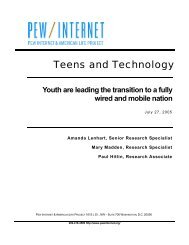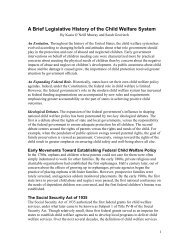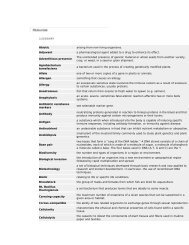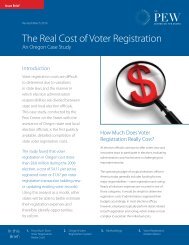After Heparin: - The Pew Charitable Trusts
After Heparin: - The Pew Charitable Trusts
After Heparin: - The Pew Charitable Trusts
Create successful ePaper yourself
Turn your PDF publications into a flip-book with our unique Google optimized e-Paper software.
PHARMACEUTICAL MANUFACTURING: GLOBALIZATION AND QUALITY MANAGEMENT<br />
2. Require clear, strong, quality agreements for suppliers. Quality expectations should be clearly<br />
established for, and contractually agreed to, by suppliers. Agreements should acknowledge U.S.<br />
quality requirements and establish that, if necessary, FDA officials will have access to a supplier’s<br />
plant. Agreements should also require suppliers and contractors to report manufacturing changes<br />
to the purchasing company. If possible, quality agreements should be included as a part of main<br />
supplier contracts to clearly set expectations.<br />
3. Increase information sharing among industry to ensure supply chain safety. Industry should<br />
share information on suppliers, risk signals, and other global market data that might help to<br />
ensure product quality and safety. Legal barriers to information sharing should be actively addressed<br />
through antitrust waivers, if necessary, or safe-harbor provisions in contracts.<br />
C. Enhance documentation and transparency of the upstream manufacturing supply chain<br />
through legal requirements.<br />
1. Companies should know and be able to document the companies involved in their upstream<br />
manufacturing supply chain. Drug companies must know the entities involved in the<br />
manufacture, processing, and transportation of their drugs and active ingredients. This documentation<br />
should be available to regulators on demand.<br />
2. Require all drug companies to state country of origin for their drugs and active pharmaceutical<br />
ingredients on their websites. Pharmaceuticals should not be subject to less transparency<br />
than other consumer products. Country of origin should be listed for both the finished drug and<br />
the drug’s active ingredients. While pharmacy dispensing may make country-of-origin labeling<br />
on drug bottles less useful for consumers, this information could be made available to the public<br />
through other means, such as package inserts or on a company’s website.<br />
D. Improve testing standards<br />
1. Industry and regulators must continually seek to develop better testing methods to ensure<br />
the identity, purity and safety of drugs. Manufacturers must be responsible for ensuring the<br />
purity of their drugs and drug components through robust testing methods, and should review<br />
and update analytic methods in an ongoing manner. Regulators and industry stakeholders agree<br />
that better methods for detecting and measuring drug contamination are needed. In addition to<br />
improving their methods, drug companies could use multiple assays as a check against bad actors<br />
who might try to design fake ingredients that are able to fool specific tests.<br />
2. Require continual assessment and updating of public testing standards. Compendial testing<br />
standards should be regularly reviewed to ensure adequacy. <strong>The</strong> FDA and USP should work together<br />
to ensure that public standards are robust and up to date, and identify and prioritize those<br />
assays that need to be updated and/or revised.<br />
<strong>After</strong> <strong>Heparin</strong>: PRotecting Consumers from the Risks of Substandard and Counterfeit Drugs 43
















